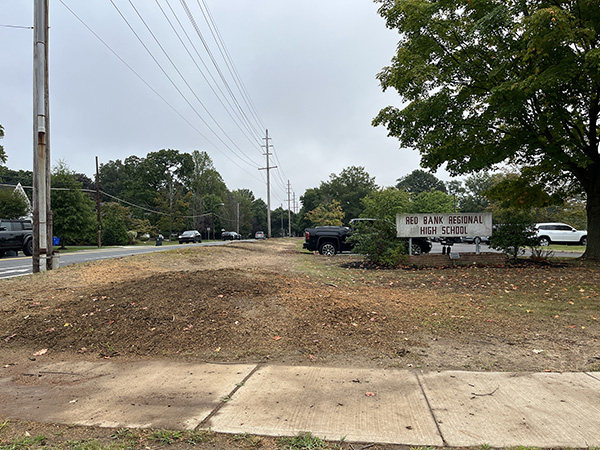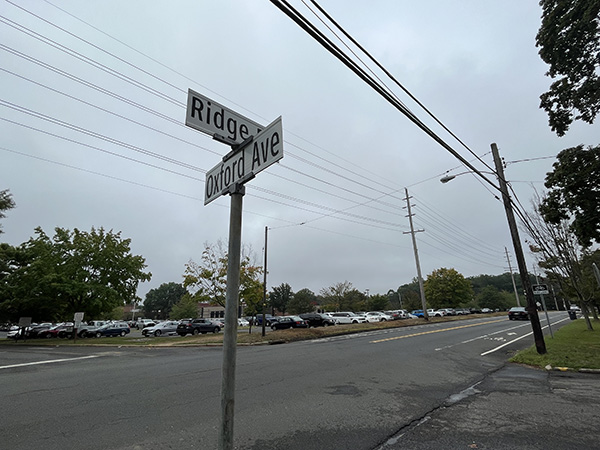
By Sunayana Prabhu
LITTLE SILVER – Nearly 20 mature oak trees that for decades formed a dense canopy for wildlife and offered a natural buffer from traffic noise on Ridge Road were felled by Jersey Central Power & Light (JCP&L) last month, unleashing a public outcry across Little Silver, Fair Haven and beyond.
After JCP&L cut down the trees outside Red Bank Regional High School Aug. 29 and 30, what ensued was a round robin of finger pointing.
Bonnie Torcivia, a resident of Fair Haven, noted the large trees were being removed after having already been trimmed several weeks prior.
“I pulled into the parking lot when I saw what was happening and spoke briefly with Maureen Campbell, an arborist with JCP&L, who told me the removal was authorized by both the Red Bank school administration and the Borough of Little Silver,” Torcivia said in an email to The Two River Times.
Joseph Loftus, chairman of the Little Silver Shade Tree Commission, said they were not informed about the initial trimming. “Little Silver and the shade tree commission were not consulted or given any information until after the fact,” he said. He explained that the shade tree commission has no jurisdiction over the trees since they were growing on a county road and Red Bank Regional High School property.
According to Loftus, the trees weren’t trimmed “prudently” by JCP&L. “They weren’t trimmed to preserve,” he said, which caused a potential safety issue.
“But we don’t have any say as to what they do,” Loftus said. “Ultimately, that’s a question for JCP&L to answer.”
Louis Moore, Ph.D., superintendent of Red Bank Regional High School District, agreed with Loftus. He insists “JCP&L did not make an effort to confirm” the school was aware of the initial pruning project. “I would just say it was a decision made unilaterally by JCP&L,” he said.
Once the pruning project was complete, flaws in its execution were obvious.
“The fundamental truth is that the pruning damaged trees, so much so that when we asked the county and the town to look at the trees, it was reported to us that many of the trees were actually compromised,” Moore said. “In other words, the trees were either in the process of dying, or if they weren’t dying, they could potentially be a hazard.”
Moore said the school reached out to representatives of the county and JCP&L and “JCP&L took responsibility to finish the job. They came back and they removed the damaged, compromised trees.”
Now the board of education is “looking for ways to ameliorate the issue,” he said.
Chris Hoenig, a spokesperson for JCP&L, said in an email to The Two River Times that “it was the town and county’s decision to remove the trees, not JCP&L’s.” He did not address the pruning issues.
County director of public information Tricia Ring Wajda said in an emailed statement that it was not the county’s decision to remove trees. She acknowledged that JCP&L, as part of a resiliency program, removed a portion of the foliage from the trees and that, following the “JCP&L effort, officials from Red Bank Regional requested the county remove the remaining portion of the trees trimmed.”
She added that the school could submit a request to the Monmouth County Division of Shade Tree for new trees to be planted, which Moore said is something they are curiously considering.
Monmouth County recently declared the oak the county’s official tree, but Wajda said “it does not have any rules or regulations in place specifically” for oak tree care.
Hoenig said JCP&L crews routinely trim treesalong power line corridors to specifications set by state regulators. He confirmed that “17 oak trees on Monmouth County-owned property at the school were trimmed to these specifications to proactively protect our electric equipment.” After concerns were raised by representatives of the school and the borough about the post-trimming appearance of the trees, JCP&L consulted with the Monmouth County Division of Shade Tree, which agreed that the trees would be removed, Hoenig said.
JCP&L contractors removed the trees with county crews handling the cleanup and grinding of any remaining stumps.
Hoenig reminded all property owners to be aware of the location of power lines when considering tree planting and to make sure “trees are planted at a safe distance from any power lines and the species selected are appropriate for that location,” he said.
Residents in the area are distraught and concerned about future pruning.
Stephanie Adams of Fair Haven reached out to The Two River Times via email Aug. 30. She lives down the street from Red Bank Regional High School. “I, along with so many other residents in town, were completely gutted watching all of the trees being taken down,” Adams said. “I understand that trees and power lines are a complicated situation – but surely there was a better way!”
Mark Olsen, also a Fair Haven resident, was dumbfounded by the removal of the three-decade-old trees. He spoke at the Fair Haven Borough Council meeting Sept. 6. “Call it 700 years of growth. Removed. I don’t understand it. I don’t understand how it could have happened.”
Several residents echoed Olsen and requested the council have any tree trimming by JCP&L overseen by the borough to avoid any more loss of tree canopies in the neighborhood.
Council member Tracy Cole empathized with the residents, highlighting the loss in a time when climate change is a global conversation. “Over 30 years those oak trees captured 12,000 pounds of carbon, six tons,” she said. “And when they cut down trees, most of that CO2 was released back into the atmosphere.”
One oak tree will absorb 20 pounds of carbon dioxide a year and release oxygen in exchange, Cole explained. “Multiplied by 20 trees, that’s 400 pounds of CO2 a year.” Additionally, one oak can absorb 1,500 gallons of stormwater runoff; “multiplied by 20 oaks, that’s 33,360 gallons of stormwater runoff,” she said.
In a May 3 statement, James Fakult, president of New Jersey Operations for FirstEnergy Corp., JCP&L’s parent company said: “Trees and branches falling on power lines and equipment are a leading cause of outages. Trimming trees near power lines is a year-round effort designed to minimize the impact of tree-related outages and restore power faster when they do occur.” The program includes trimming along more than 3,400 miles of power lines across 13 county service territories.
“With hot weather and summer storms around the corner, this proactive work is one of the best steps we can take to help keep the lights on for our customers,” Fakult said.
“I understand that tree trimming is necessary to a degree and that power lines are critical,” said Torcivia, “but my fear is that power companies have little regard for the value of trees and town administrators prefer to just eliminate the sources of complaints.”
According to Torcivia, the trees “could have easily lived for another 100 years.”
“We mourn not only the loss of the trees, their beauty and their critical part in our ecosystem,” said Adams, “but their root systems as well. All those carbon sinks, dug up, and emissions released! Up to 20% of greenhouse gas emissions can come from deforestation and changes to the land – yet we continue to dig up our trees.”
In its statement, JCP&L said that, since Jan. 1, the company’s contractors have trimmed trees along more than 700 miles of power lines, with an additional 2,700 miles expected to be completed by year end. JCP&L’s statement listed a number of other Two River-area towns scheduled for the tree-trimming program, including Red Bank, Lincroft, Sea Bright, Colts Neck, Oceanport, Tinton Falls, Long Branch and Monmouth Beach, among others.
The article originally appeared in the September 15 – 21, 2022 print edition of The Two River Times.















